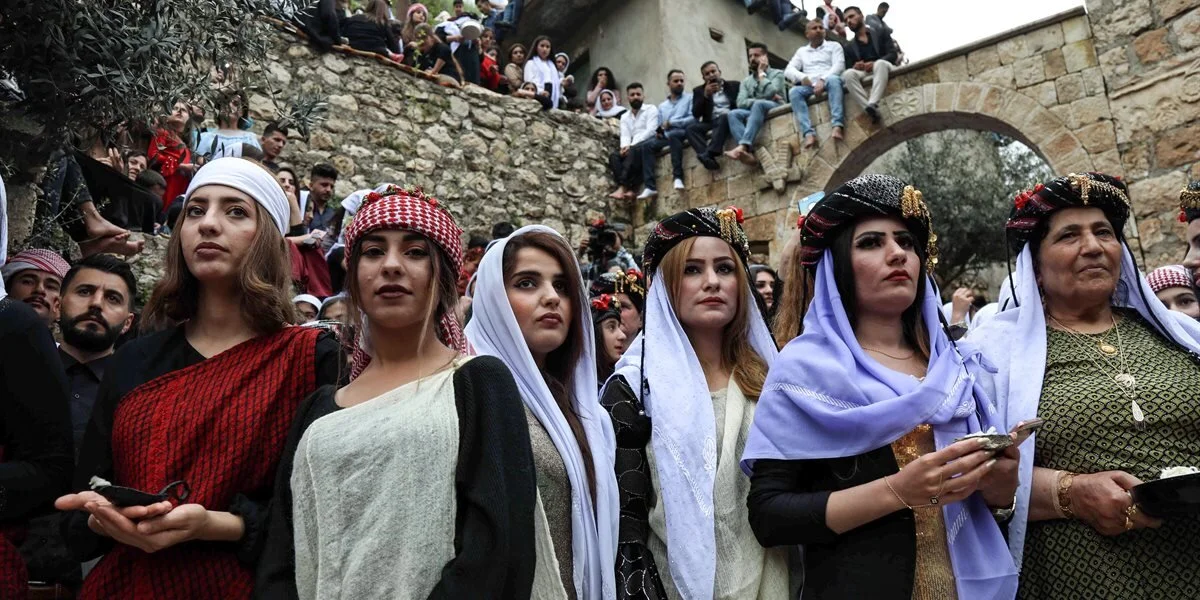The Yazidis are an ethno-religious minority with ancestral roots in Iraq, Turkey, Syria, and Iran. Today, the majority of Yazidis live in disputed areas in northern Iraq, specifically in the Sheikhan and Sinjar (Shingal) districts, with smaller communities present in Turkey, Syria, Armenia, Georgia, and Russia, as well as there is a large Yazidi diaspora in Western countries, especially in Germany. The majority of Yazidis speak standard Kurmanji which is considered the principal Kurdish dialect. Linguistically, Yazidis are not homogenous. Some Yazidis speak other languages as a mother tongue, such as the Bashiqa and Bahzanian language (dialect) which is close to some Levantine Arabic dialects.
Based on misinterpretations, stereotypes, and false information about the Yazidis’ religion, especially by their Muslim neighbours such as the Sunni Kurdish Muslims and Turks, the Yazidi people have long been persecuted as “devil worshippers” across the region and subjected to at least seventy-two firmans (pogroms or genocides) during the Ottoman Empire.
The Yazidi religion has attracted the attention of researchers more than any other religion in Iraq. For the most part, they disagree on the origin of the name, on the religion and on the core and essential beliefs of the Yazidi. Within academic circles different terms are used to refer to Yazidis: sub-ethno group, sub-ethno-confessional group, ethnic group, confession, ta’ifa (sect or non-Muslim), and ethno-religious. In terms of religious origin, some claim that the Yazidi religion comes from the Sabean-Mandaeans, citing the similarity of rituals in both religions. Others claim that the Yazidi are of Christian origin, on the grounds that baptism, belief in Christ, and respect for churches are common to both religions. In eddition scholars consider many of the doctrinal elements of the Yezidi faith as linked to other religions, such as Islam, Christianity, and Zoroastrianism.
There is much uncertainty in academic circles on the origins of the ‘Yazidi’ name and their denomination. The ‘supreme being’ of the faith is Yazdan, considered so holy that he cannot be directly worshipped, “he is considered a passive force, the Creator of the world, not the preserver.” They believe in one God, Xwedê. Malak Taus, a ‘peacock angel’ to whom the Yazidis pray five times a day, is one of the holy trinity emanating from Yazdan, alongside Sheikh 'Adi, and Sultan Êzî, and is revered as His alter-ego, thus the monotheistic denomination of the Yazidi religion.
We are able to identify and divide the history of the Yazidis into two basic phases as follows:
The first phase: This is the stage prior to the reign of Sheikh-Adi, in which the Yazidi religion existed and was based primarily on rituals, mythology, customs, and traditions, partly oral and partly written, and during which time the Yazidis were known as Dasini. It must be noted here, that the name of the Yazidi religion and nation has changed over the course of history.
The second phase: The second stage began in the 12th century CE with the advent of Shaykh-Adi and his arréfc ival at the Lalish Temple (located in Iraqi Kurdistan region), a highly significant centre of worship to the Yazidi people.
The secretive nature of the Yazidi faith has led to persecution through the centuries. Modern Yazidis are acutely aware of the violence and prejudice suffered by their ancestors, with this brutality leaving “deep cultural scars.” Yazidi tradition is passed down orally, and it is forbidden for a Yazidi to marry outside the community, or he or she will be considered an outsider. Likewise, it is not possible to join the Yazidi faith, one must be born into it.
The Yazidi community received global attention in 2014, when an ethnic cleansing program carried out by ISIS resulted in the murder, displacement and enslavement of thousands of Yazidi men, women and children. Estimates of the current size of the Yazidi community range from 700,000,000 to 1000,000, with the diaspora reaching across the Middle East, Turkey, the Caucasus, and Europe, especially following the mass migration of refugees in the wake of the 2014 genocide.
Video: Seth Eislund
Text: Callum Hamilton


